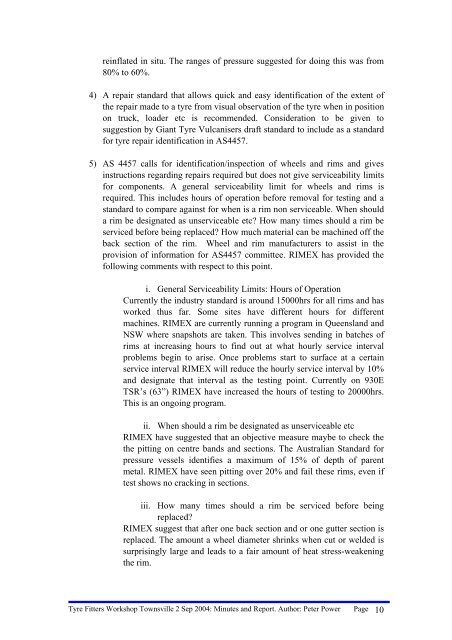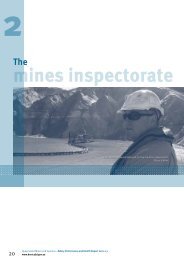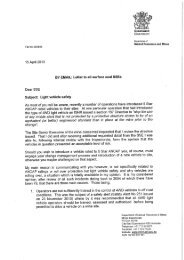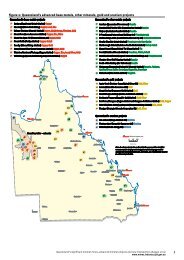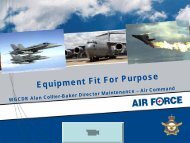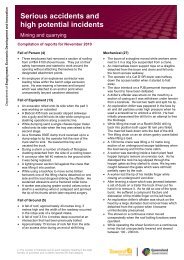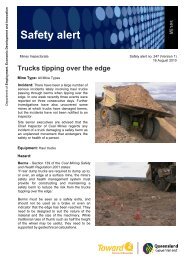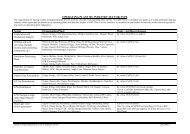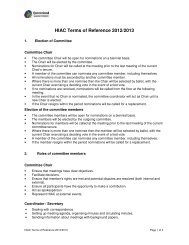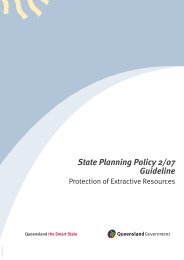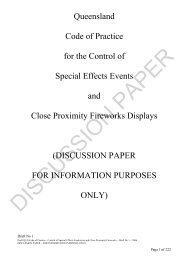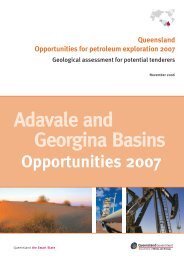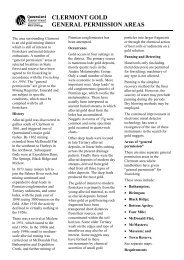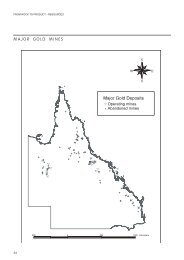(Introduction, results, summary) (PDF, 69 kB) - Queensland Mining ...
(Introduction, results, summary) (PDF, 69 kB) - Queensland Mining ...
(Introduction, results, summary) (PDF, 69 kB) - Queensland Mining ...
You also want an ePaper? Increase the reach of your titles
YUMPU automatically turns print PDFs into web optimized ePapers that Google loves.
einflated in situ. The ranges of pressure suggested for doing this was from<br />
80% to 60%.<br />
4) A repair standard that allows quick and easy identification of the extent of<br />
the repair made to a tyre from visual observation of the tyre when in position<br />
on truck, loader etc is recommended. Consideration to be given to<br />
suggestion by Giant Tyre Vulcanisers draft standard to include as a standard<br />
for tyre repair identification in AS4457.<br />
5) AS 4457 calls for identification/inspection of wheels and rims and gives<br />
instructions regarding repairs required but does not give serviceability limits<br />
for components. A general serviceability limit for wheels and rims is<br />
required. This includes hours of operation before removal for testing and a<br />
standard to compare against for when is a rim non serviceable. When should<br />
a rim be designated as unserviceable etc? How many times should a rim be<br />
serviced before being replaced? How much material can be machined off the<br />
back section of the rim. Wheel and rim manufacturers to assist in the<br />
provision of information for AS4457 committee. RIMEX has provided the<br />
following comments with respect to this point.<br />
i. General Serviceability Limits: Hours of Operation<br />
Currently the industry standard is around 15000hrs for all rims and has<br />
worked thus far. Some sites have different hours for different<br />
machines. RIMEX are currently running a program in <strong>Queensland</strong> and<br />
NSW where snapshots are taken. This involves sending in batches of<br />
rims at increasing hours to find out at what hourly service interval<br />
problems begin to arise. Once problems start to surface at a certain<br />
service interval RIMEX will reduce the hourly service interval by 10%<br />
and designate that interval as the testing point. Currently on 930E<br />
TSR’s (63”) RIMEX have increased the hours of testing to 20000hrs.<br />
This is an ongoing program.<br />
ii. When should a rim be designated as unserviceable etc<br />
RIMEX have suggested that an objective measure maybe to check the<br />
the pitting on centre bands and sections. The Australian Standard for<br />
pressure vessels identifies a maximum of 15% of depth of parent<br />
metal. RIMEX have seen pitting over 20% and fail these rims, even if<br />
test shows no cracking in sections.<br />
iii. How many times should a rim be serviced before being<br />
replaced?<br />
RIMEX suggest that after one back section and or one gutter section is<br />
replaced. The amount a wheel diameter shrinks when cut or welded is<br />
surprisingly large and leads to a fair amount of heat stress-weakening<br />
the rim.<br />
Tyre Fitters Workshop Townsville 2 Sep 2004: Minutes and Report. Author: Peter Power Page 10


